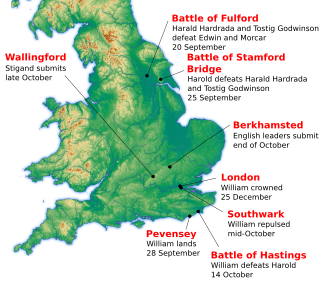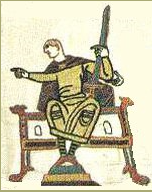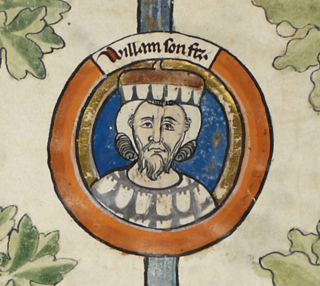
William I, usually known as William the Conqueror and sometimes William the Bastard, was the first Norman king of England, reigning from 1066 until his death in 1087. A descendant of Rollo, he was Duke of Normandy from 1035 onward. By 1060, following a long struggle to establish his throne, his hold on Normandy was secure. In 1066, following the death of Edward the Confessor, William invaded England, leading an army of Normans to victory over the Anglo-Saxon forces of Harold Godwinson at the Battle of Hastings, and suppressed subsequent English revolts in what has become known as the Norman Conquest. The rest of his life was marked by struggles to consolidate his hold over England and his continental lands, and by difficulties with his eldest son, Robert Curthose.

Harold Godwinson, also called Harold II, was the last crowned Anglo-Saxon English king. Harold reigned from 6 January 1066 until his death at the Battle of Hastings, fighting the Norman invaders led by William the Conqueror during the Norman Conquest of England. His death marked the end of Anglo-Saxon rule over England.

The Battle of Hastings was fought on 14 October 1066 between the Norman-French army of William, the Duke of Normandy, and an English army under the Anglo-Saxon King Harold Godwinson, beginning the Norman Conquest of England. It took place approximately 7 mi (11 km) northwest of Hastings, close to the present-day town of Battle, East Sussex, and was a decisive Norman victory.

The Bayeux Tapestry is an embroidered cloth nearly 70 metres long and 50 centimetres tall that depicts the events leading up to the Norman Conquest of England in 1066, led by William, Duke of Normandy challenging Harold II, King of England, and culminating in the Battle of Hastings. It is thought to date to the 11th century, within a few years of the battle. Now widely accepted to have been made in England perhaps as a gift for William, it tells the story from the point of view of the conquering Normans and for centuries has been preserved in Normandy.

The Norman Conquest was the 11th-century invasion and occupation of England by an army made up of thousands of Norman, Breton, Flemish, and French troops, all led by the Duke of Normandy, later styled William the Conqueror.

Eustace II,, also known as Eustace aux Grenons, was Count of Boulogne from 1049 to 1087. He fought on the Norman side at the Battle of Hastings, and afterwards received large grants of land forming an honour in England. He is one of the few proven companions of William the Conqueror. It has been suggested that Eustace was the patron of the Bayeux Tapestry.

Odo of Bayeux was Bishop of Bayeux in Normandy, and was also made Earl of Kent in England following the Norman Conquest. He was the maternal half-brother of duke, and later king, William the Conqueror, and was, for a time, William's primary administrator in the Kingdom of England.
William of Poitiers was a Frankish priest of Norman origin and chaplain of Duke William of Normandy, for whom he chronicled the Norman Conquest of England in his Gesta Willelmi ducis Normannorum et regis Anglorum or Gesta Guillelmi II ducis Normannorum. He had trained as a soldier before taking holy orders.

Robert, Count of Mortain, first Earl of Cornwall of 2nd creation was a Norman nobleman and the half-brother of King William the Conqueror. He was one of the very few proven companions of William the Conqueror at the Battle of Hastings and as recorded in the Domesday Book of 1086 was one of the greatest landholders in his half-brother's new Kingdom of England.
William Malet held senior positions within the Norman forces that occupied England from 1066. He was appointed the second High Sheriff of Yorkshire in 1068. Of the so-called companions of William of Normandy, Malet is one of about a dozen for whom there is evidence of their presence at the Battle of Hastings of 14 October 1066. For example, the contemporary chronicler William of Poitiers recorded that Malet was present at the battle.
Robert de Beaumont, 1st Earl of Leicester, Count of Meulan, also known as Robert of Meulan, was a powerful Norman nobleman, one of the very few proven Companions of William the Conqueror during the Norman Conquest of England in 1066, and was revered as one of the wisest men of his age. Chroniclers spoke highly of his eloquence and his learning, and three kings of England valued his counsel. He was granted immense land-holdings in England by William the Conqueror and by Henry I and was created Earl of Leicester.
The Battle Abbey Roll is a commemorative list, lost since at least the 16th century, of the companions of William the Conqueror, which had been erected or affixed as a memorial within Battle Abbey, Hastings, founded ex-voto by Duke William on the spot of the slaying of King Harold in the Battle of Hastings in 1066.
The Carmen de Hastingae Proelio is a 20th-century name for the Carmen Widonis, the earliest history of the Norman invasion of England from September to December 1066, in Latin. It is attributed to Guy, Bishop of Amiens, a noble of Ponthieu and monastically-trained bishop and administrator close to the French court, who eventually served as a chaplain for Matilda of Flanders, William the Conqueror's queen. Bishop Guy was an uncle to Guy I, Count of Ponthieu, who figures rather prominently in the Bayeux Tapestry as the vassal of Duke William of Normandy who captured Harold Godwinson, later to become King Harold II of England, in 1064.

Guy I of Ponthieu was born sometime in the mid- to late 1020s and died 13 October 1100. He succeeded his brother Enguerrand as Count of Ponthieu.

Roger de Beaumont, feudal lord of Beaumont-le-Roger and of Pont-Audemer in Normandy, was a powerful Norman nobleman and close advisor to William the Conqueror.

William Longsword was the second ruler of Normandy, from 927 until his assassination in 942.

Turstin fitz Rolf, also known as Turstin le Blanc and Tustein fitz Rou played a prominent role in the Norman conquest of England and is regarded as one of the few proven companions of William the Conqueror at the Battle of Hastings in 1066.

Hamon Dentatus was a Norman baron who was killed while rebelling with other Norman barons against William II, Duke of Normandy at the Battle of Val-ès-Dunes. The epithet "Dentatus" or "Dens" was probably given to Hamon because he was born with teeth. Little is known about Hamon's life.
Hugh of Eu(Hugues, Hugo) was Bishop of Lisieux from 1049 to 1077.
The Council of Lillebonne was a meeting of the nobles and clergy of Normandy where, among other things, the expedition of William the Conqueror, then Duke of Normandy, was approved. It was held at Lillebonne, in the northeast of Normandy. Wace, the 12th-century historian, wrote of the council, convened shortly before the actual invasion, likely in January 1066. William of Poitiers, a chronicler of the Norman invasion, claims that the duke also obtained the consent of Pope Alexander II for the invasion, along with a papal banner.
![Companions of the Conqueror fighting at Hastings, as depicted in the Bayeux Tapestry. The Duke is on the right, and shows his face to encourage his followers. Legend above: Hic Est Dux Wilel(mus) ("Here is Duke William.") At the left is Bishop Odo. Legend above: Hic Odo Eps (Episcopus) Baculu(m) Tenens, "Here (is) Odo the Bishop holding a club" (see detail below). To the far right, holding a standard, is Eustace, Count of Boulogne (see detail below), with legend above, in upper margin: E[...]TIUS, standing for Eustatius, a Latinised version of "Eustace." The figure is said by others to be Turstin FitzRolf, said by Orderic Vitalis to have carried the Norman standard: Turstinus filius Rollonis vexillum Normannorum portavit, "Turstin son of Rollo carried the standard of the Normans," The Tapestry however depicts it as the Papal Banner, a cross, granted to the Duke by Pope Alexander II to signify papal approval of the Conquest of England. DukeWilliamAtHastings.jpg](http://upload.wikimedia.org/wikipedia/en/thumb/0/02/DukeWilliamAtHastings.jpg/300px-DukeWilliamAtHastings.jpg)
![This knight depicted in the Bayeux Tapestry (detail of above) appears below the marginal legend E[...]tius, a Latinised version of Eustace. He has therefore been identified as Eustace, Count of Boulogne. His finger pointing to Duke William seems to depict his urging the Duke to retreat, as the account in William of Poitiers relates. However, others state the figure to be Turstin FitzRolf, due to its carrying of a standard depicting a cross, apparently the Papal Banner. Turstin was described as having carried the "Standard of the Normans," by Orderic Vitalis. Eustache de Boulogne-Bayeux.png](http://upload.wikimedia.org/wikipedia/commons/thumb/1/19/Eustache_de_Boulogne-Bayeux.png/200px-Eustache_de_Boulogne-Bayeux.png)












